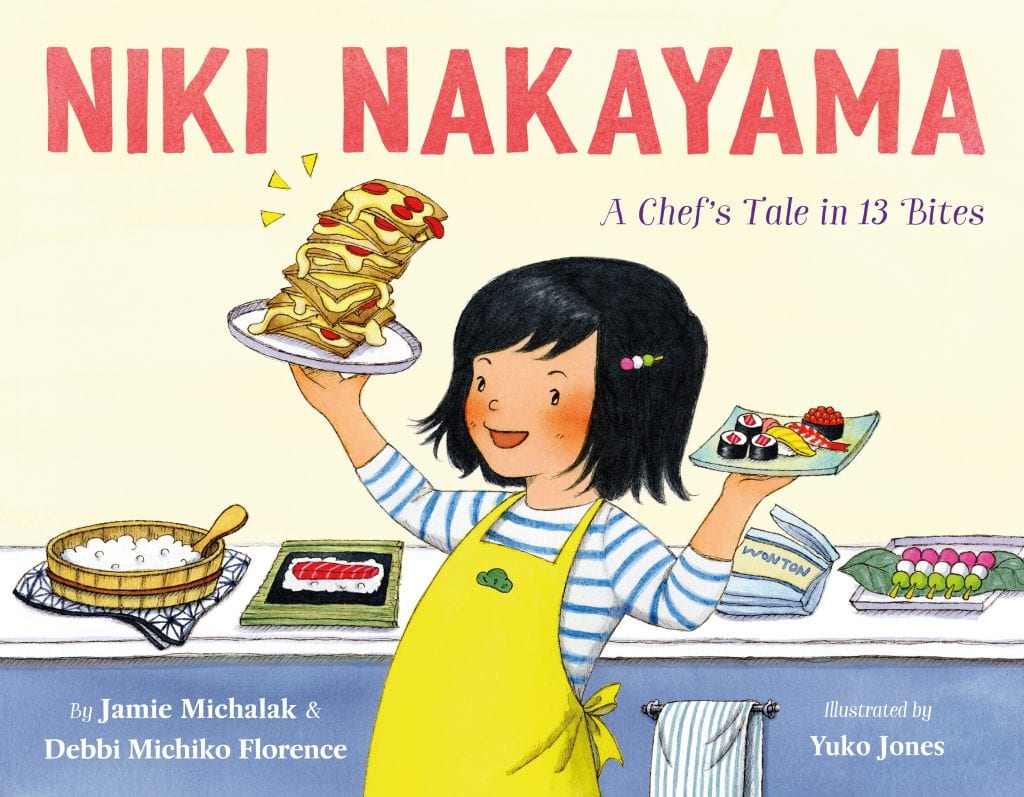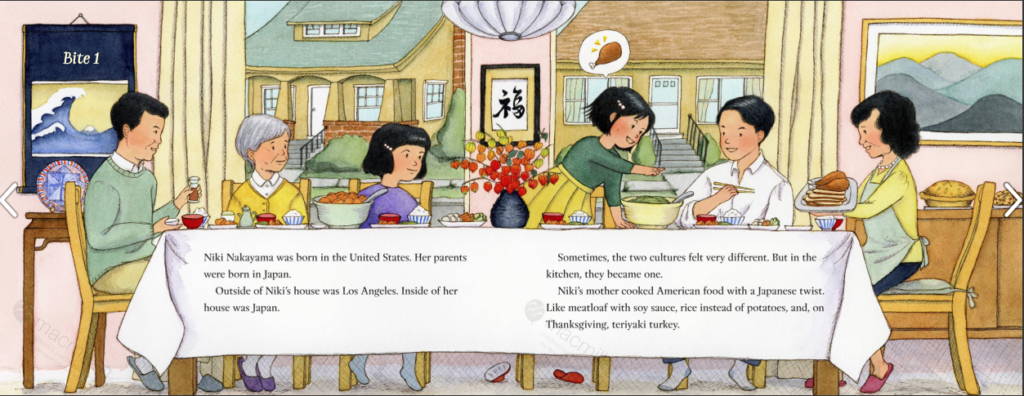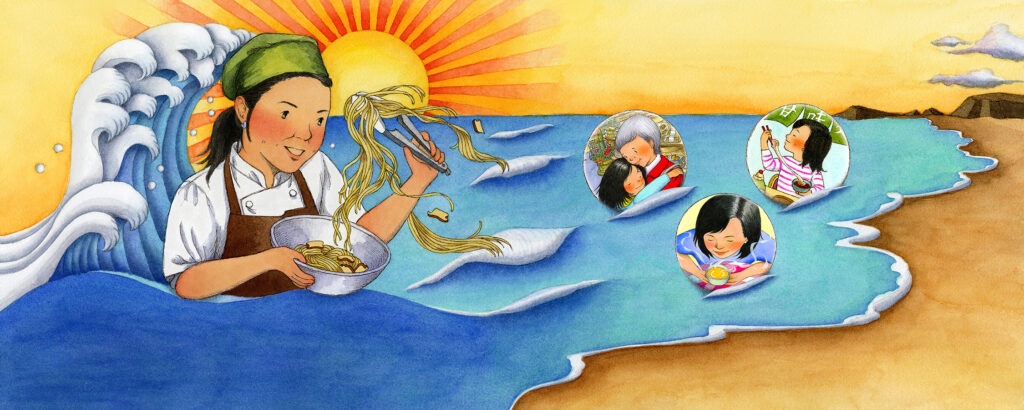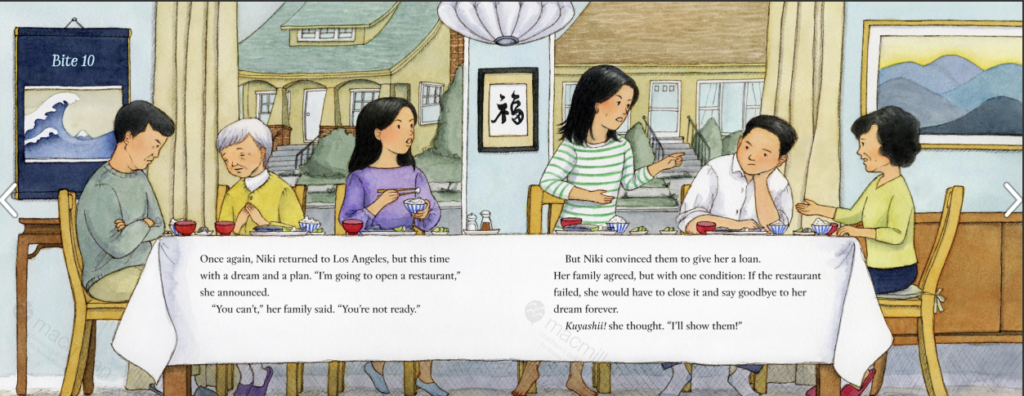Foodie picture book biographies are totally my jam. So I’m super excited to share NIKI NAKAYAMA: A Chef’s Tale in 13 Bites with you today. Co-authors Jamie Michalak and Debbi Michiko Florence, plus debut pb illustrator Yuko Jones were kind enough to answer some questions — and they’re giving away books AND art!

Here’s the publisher’s delicious description:
Niki Nakayama: A Chef’s Tale in 13 Bites is a picture book biography that tells the story of the powerhouse female Japanese-American chef and her rise to fame. As a child and adult, Niki faced many naysayers in her pursuit of haute cuisine. Using the structure of a traditional kaiseki meal, the authors Debbi Michiko Florence and Jamie Michalak playfully detail Niki’s hunger for success in thirteen bites — from wonton wrappers she used to make pizza as a kid to yuzu-tomatillo sauce in her own upscale Los Angeles Michelin-starred restaurant, n/naka. To anyone who tells her a woman can’t be a master chef, Niki lets her food do the talking. And oh, does it talk. Niki was featured on the first season of Netflix’s culinary documentary series Chef’s Table. And Chrissy Teigen proclaimed that Niki’s restaurant was one of her absolute favorites. She’s currently a featured teacher on MasterClass. A smart, strong woman with starpower, Niki is only just getting started — like the young readers who will devour this book, featuring illustrations by Yuko Jones!
Booklist and Publisher’s Weekly have each given the book starred reviews, with Booklist saying, “Art, storytelling, and food work together on so many levels in this beautiful tale about master chef Niki Nakayama’s life.” I couldn’t agree more! Here’s my interview with the creators about these elements:
Welcome, Jamie, Debbi, and Yuko! Thank you so much for being on the blog with me today!
ANDREA: The structure of the book is so unique — it’s told in thirteen “bites,” which parallel the thirteen dishes that Niki serves at her restaurant, n/naka. Jamie, did you have this structure in mind from the beginning, and how did you approach separating Niki’s story into each bite? In other words, what did you hope to show/accomplish in each “bite?”
JAMIE: The original version followed a more traditional approach. But because kaiseki is a meal that tells a story, it became clear that n/naka’s 13 courses would be the perfect structure for this book. Each course, or “bite,” is a vignette that tells a part of Niki’s life story.
That’s why the opening paragraph breaks the fourth wall — we wanted to address the reader directly and welcome them to the feast: “Come, sit, taste.”
We also made sure that each bite, whether it be sushi or spaghetti, reflects the particular dish tied to that part of Niki’s life. For example, Bite 1 is rice, which as a child, Niki ate with every family meal. Yuko did a great job of including each bite in the art in different ways, both obvious and subtle.
(Side note: it’s fun to think about what you’d include in your own 13-bite meal about your life!)

ANDREA: There would definitely be chocolate in one of the bites about my life! Debbi, I understand from your launch party that you wrote the first two paragraphs in Bite 1, which talks about the duality in Niki’s life. What made you decide to start the story this way?
DEBBI: Jamie and I discovered a wonderful way of co-authoring this book. Neither of us had co-authored before so we made it up as we went. She would write a draft and send it to me and then I’d work on it, rewriting, cutting, tweaking. And then I’d send it back to her. And she would do the same, going through the draft, and revising and writing. Back and forth we went until we felt satisfied with the end product. I don’t often recall exactly which lines were ones I wrote, but Jamie kindly pointed this out at our launch party – that I’d written the opening for the first “bite.”
Niki Nakayama is Japanese American and grew up in Los Angeles. I am also Japanese American and grew up in Los Angeles. In reading and learning about her story, I could relate to what it was like to combine two cultures into one. I grew up eating Japanese rice with every meal, even spaghetti. It wasn’t until I was older and went to a (non-Japanese) friend’s house and had spaghetti that I learned that not everyone had Japanese rice with every meal. My family celebrated American holidays, like Christmas and Thanksgiving and we also celebrated Japanese holidays or with Japanese traditions, like Girls’ Day and New Year’s with a large Japanese feast. And so because Niki’s culture and heritage play a big part of who she is and what she creates, I felt that it was important to open the story with something that highlighted that aspect. I’m glad it worked.
ANDREA: It works really well–the reader now has a basis for understanding what motivated young Niki. Yuko, your illustrations are so gorgeous and detailed! Could you tell us a little about your research process? What were you able to draw from your own experiences and what did you have to learn more about?
YUKO: Thank you for your kind words! The publisher sent me several photos of Niki and her family when I started this project, so I used them for character development. Watching Niki Nakayama’s episode on “Chef’s Table” was also helpful as I could see her in action and her personality. I googled pictures for the things I didn’t know how to draw. For example in Bite 3, I had no idea what a seafood warehouse would look like, so I researched online to get some ideas. I also had fun incorporating Japanese elements into the illustrations based on my own experiences. The Japanese scroll artwork in Bites 1 and 10, for example, are inspired by The Great Wave by a Japanese woodblock printmaker, Hokusai from early 1800s. The same motif appears again in Bite 12, where Niki is inventing her pasta dish with the big waves crashing behind her in the background. The rising sun is also a nod to traditional Japanese art. If you pay close attention, you’ll find a lot of fun little details like these throughout the book.

ANDREA: That’s fascinating about the details that pay homage to traditional Japanese motifs! Speaking about traditions, a lot of the tension in the story comes from the cultural differences between Niki’s parents, who were born in Japan, and Niki herself, who was born in the United States. Debbi, how did you approach balancing the Japanese and American sides of Niki in the text? Was it important to you to include Japanese words, for instance?
DEBBI: I think between Jamie and myself, we were able to take all the key moments of Niki’s life and share them bite by bite. The whole drive behind Niki’s push for pursuing her dreams was that for Niki the Japanese culture dished up some obstacles. Her parents placed greater value on the achievements of Niki’s brother, because he was a boy. That is part of the culture that her parents brought over from Japan back then. Niki wanted to be a kaiseki chef, but, in Japan, cooking methods and secrets were handed down from male to male (father to son, mentor to apprentice). But the Japanese culture also dished up treats for Niki. Niki traveled to Japan and was intrigued by the food, and when she experienced traditional kaiseki for the first time, she was hooked. It was important to include all parts of Niki and her journey and yes, that included some Japanese words, especially the word kuyashii, which is the feeling one has when frustrated by doubters and naysayers – that “I’ll show you” feeling. That was a driving force for Niki and her determination to succeed and make her dreams come true.
ANDREA: Kuyashii shows Niki’s personality so well! One of the many things I love about the book are the themes of believing in yourself and following your dreams. Jamie, can you share a little about what inspired you to write about Niki and what you hope young readers will take away from the story?
JAMIE: Yes, that was the big hook for me. I love sports movies about the underdog, and watching Niki’s “Chef’s Table” episode gave me all the same feelings — you can’t help but root for her. Chef Niki’s quiet determination is inspiring and motivating. She’s not loud or flashy. When the naysayers doubted her dream, instead of wasting her breath defending herself, she showed them through her actions. She let her food do the talking.
Not letting anyone else tell you who you are is an important lesson for kids on so many levels. Being true to yourself and speaking through your actions is powerful, too, especially in this “look at me!” world where it sometimes seems like you have to be loud to succeed.
ANDREA: Yes, I totally agree that quiet actions can be as effective (or more so) than loud gestures. One last question for you about the art, Yuko. The illustrations are a wonderful mix of scenes, panels, spot art, and even a map. Sometimes the illustration is realistic, and other times they are slightly fantastical, such as when fish leap out of a painting on the wall. How do you decide on what the composition of each page should be?
YUKO: I tried to mix up different compositions, from spot illustrations to full bleed spreads, to keep it visually interesting. But the shape of the book also played an important role in deciding the overall format. The book is quite wide when it’s open. So I took advantage of the shape and let the elements visually flow from left to right throughout the story. For example, in Bite 9, I let the seasons transition from left to right, from summer to winter. I took a more fantastical approach in some of the pages, like the fish leaping out of a painting, just because it felt like the right way to capture Niki’s imagination.

YUKO: Bites 1 and 10 were inspired by Leonard da Vinci’s The Last Supper. I thought its dramatic composition works well in those spreads and I wanted Niki to be the center of attention. I repeated the same composition twice to contrast the moods between those two scenes, and how much they have changed over time. Here’s another interesting detail: I grew up reading “manga” comic books, so I thought it would be fun to add speech bubbles and Japanese sound effects to the illustrations just like the ones you see in those comic books.

ANDREA: Okay, since I’m borderline obsessed with food, I have to ask each of you — what is your favorite Japanese food?
DEBBI: This is a really hard question. I love most all Japanese food! Favorite comfort food is Japanese curry over rice. Favorite food to eat in Japan is ramen. Favorite childhood food item is umeboshi (pickled plum that is really an apricot). And always, I love (really good) sushi. For dessert, mochi is a favorite. See? It’s too hard to pick one!
JAMIE: Oh gosh, I love it all. Uni is a special treat. I also love okonomiyaki, as well as onigiri with umeboshi. Researching this book was the best, especially getting the opportunity to dine at n/naka and meet Chef Niki in person.
YUKO: My favorite Japanese food is sushi, and I’d eat it every day if I can. I make temaki sushi (hand-rolled sushi) at home and it’s a fun thing to cook with kids.

ANDREA: All of that sounds amazing! Now I’m craving Japanese food! And lastly, what’s next in the publishing pipeline for each of you?
JAMIE: My next books are two different sorts of food books. Inspired by my big dream of owning a food truck, there’s Frank and Bean: Food Truck Fiasco, the second Frank and Bean early reader, illustrated by Bob Kolar (Candlewick, 2022). Also, Come On In: There’s a Party in This Book, illustrated by Sabine Timm, is on the launch list of Jill Davis’s new Astra imprint, Hippo Park (Fall 2022). It stars an endearing lemon. [Find out more about Jamie at www.jamiemichalak.com & follow her on Twitter @Jamie_Michalak and IG @JamieMichalakBooks]
YUKO: As for projects, I don’t have anything lined up at the moment, but I’m a firm believer that the right project will come at the right time. [Find out more about Yuko at www.yukojones.com and follow her on Twitter @StudioYukoJones and IG @StudioYukoJones]
DEBBI: I have an upper middle grade novel, Sweet and Sour, about friendship, betrayal, and revenge coming out on May 17, 2022 with Scholastic. And right now I’m working on four new books in the Jasmine Toguchi chapter book series with Farrar Straus Giroux. I believe the first one will publish near the end of 2022. [Find out more about Debbi at www.debbimichikoflorence.com and follow her on Twitter @DebbiMichiko and IG @Debbi_Michiko_Florence]
Thank you all so much for chatting with me on Picture Book Builders!! I can’t wait for everyone to get their hands on your gorgeous book — which brings me to the giveaways! Jamie and Debbi are giving away a signed book and bookmark, and Yuko has generously offered to give away a book and a 5×7-inch original artwork featuring Niki! Please leave a comment below by October 29th to enter. Two winners will be chosen at random. Domestic U.S. addresses only, please. Good luck!

This book looks delicious down to the very last bite. Thanks for the introduction to Jamie, Debbi, Yuko and of course, NIKI NAKAYAMA! 🙂
I see what you did there! ? Yes, it’s a very edible book!
This sounds like a great idea for a picture book, and I love the illustrations, especially that scene at the family dining table!
I loved learning that Yuko used The Last Supper as her inspiration for the dining table scenes. I was like, no wonder they feel familiar… ?
Yum! This book looks fun and delicious! Think my twins would love it!
I think they would, too! And depending on how old they are, you can make the wonton pizza recipe with them from the back of the book!
This book looks fun ! Think my twin grandkids would love it!
I foresee a Snyder Family read aloud with wonton pizzas in your future!
Hi David! You are the lucky winner of a signed copy of NIKI NAKAYAMA and a 5×7-inch piece of original artwork from illustrator Yuko Jones! Please email me at AndreaWangBooks@gmail.com with your mailing address.
This book looks yummy!
You will crave Japanese food after reading it! ?
I am so excited to read this book! The more I read about it the more I adore the unique structure and story. And it’s written by such a dream team! Fingers crossed!
I’d love to win a copy! Book looks delicious.
I’m so envious of the diners in Bite 13 who get to eat at Niki’s restaurant in LA!
This sounds fantastic. I can’t wait to dive into this book!
I think it’s groundbreaking in many ways — just like Niki herself!
A picture book about food! My favorite! This sounds fascinating and full of captivating tidbits. Congratulations to all!
I love how foodie picture books have really taken off in the past few years!
Such an innovative way to tell a biography! And showing the mix of cultures is a true American story for many of us.
So true! We are a smorgasbord of cultures!
I just read this delightful book last week. I really enjoyed it. Such an engaging story and unique structure.
So glad you’ve read it! The structure is just brilliant.
What a wonderful idea for a picture book. I love how Japanese food play a central role. And the illustrations look gorgeous!
Yes, another reason I love this book is how it normalizes Japanese food and shows readers that it’s so much more than just “raw fish.”
I enjoyed reading this new offering so much!
I love learning backstories and about impressive folks.
Written with such a unique structure, but one that totally suits the subject.
This book looks delicious and I love books that use innovative structures. Can’t wait to read it!
I love collecting books with unique structures, too. This one is just perfection!
This looks magnificent! Can’t wait to read it!
It’s inspiring in so many ways! I keep going back to pore over the details in the illustrations…
Thank you for having us for the interview, Andrea!! I had so much fun chatting with you!
Me, too! Congrats again on your stellar debut!
What an incredible look behind the pages of this treasure! Food + books= Pure joy! How Niki tells stories with her food will inspire so many you g foodies and writers. I can’t wait to hold this book n my hands.
I feel the same way about food + books! Thanks for reading our post!
What a creative structure for a picture book. I love it! The story concept of combining cultures and food is a winner. Congratulations!
I think reading about different cultures through their food is my favorite way to learn about them (aside from sampling the food, of course!).
I learned so much more about Yuko’s art process and inspiration! Thanks for hosting us, Andrea! We loved chatting with you.
Thank YOU for writing this inspiring book! xo
I also enjoy reading books that feature food and Japanese food is my favorite–I would eat sushi every day if I could. We have the largest Japanese market here in my home town and they make delicious, fresh sushi so they are my “fast food” take out choice.
I am officially envious of you and your wonderful Japanese market! ?
I love this storyline and those pictures are gorgeous!
Yuko’s color palette is so vibrant and inviting, isn’t it? ?
Hi Stephanie! You are the lucky winner of a signed copy of NIKI NAKAYAMA and a bookmark from the co-authors! Please email me at AndreaWangBooks@gmail.com with your mailing address.
This is amazing…thank you so much for sharing!
Such a clever structure & I love Yuko’s art too! Congrats, all! Looking forward to attending their event on Saturday!! Thanks for the wonderful interview, Andrea!
I really love learning about creative ways to structure stories! I have to see this one!! Fascinating!
Love food-related picture books, so I’d love to win a copy. Congrats, Yuko, Debbie & Jamie!
I loved learning that the 13 bites parallel the 13 dishes Niki made at her restaurant.
Wonderful interview, Andrea! I love reading about picture book creators and the inspiration behind their work. Congratulations, Jamie, Debbi, and Yuko! And congrats to Niki Nakayama, as well, for all her success! (The food photos in the gallery section of her restaurant website are amazing!)
Congratulations Jaime, Yuko and Debbi! What a clever way to write a biography. And I’m wowed by the art. Beautiful book. This foodie is going to savor 13 bites.
Wonderful interview! A lot of parallels from one Asian culture to the next!
thank you for the opportunity to learn a lot. Thank you!
Just requested NIKI NAKAYAMA: A Chef’s Tale in 13 Bites from my library. Can’t wait to read it for myself!
What a fun and informative interview. I’m drooling over the art, the story and all of the talk of food. I can’t wait to check out NIKI NAKAYAMA: A Chef’s Tale in 13 Bites. Congratulations to all!
Thank you for the chance to win a copy of this fun book!
What a great interview! This would be a great book to add to any library collection! It’s inspirational for budding chefs and artists alike!
This book would be great to add to our elementary school library!
Wonderful book and discussion about how the book came to be! Obviously a lot of work and labor of love. Yuko’s artwork is so beautiful and colorful that it brings much happiness to the project.
So many wonderful aspects in your book. Breaking the fourth wall, the 13 structure correlating with the meal plus the blending of food as well as family customs. Bravo !
Would love this for my girls! Their auntie is also an Asian American chef too!
I love the innovative structure and the lovely threads woven all throughout this beautiful story. Looking forward to reading (and lingering over)!
Hi Andrea- thanks for including both the authors and illustrator in your post. It’s wonderful to get both perspectives!
I loved this! what a unique structure. Thanks Andrea, I look forward to your posts!